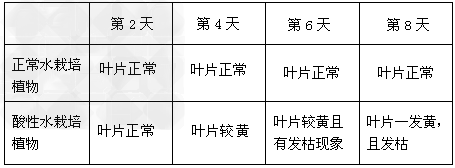问题
探究题
探究:酸性水对花卉的生长有影响吗?(提示:酸性水可采用pH小于5.6的水,也可以用家用醋与水以1:10的比例配制。)
答案
[作出假设]酸性水对植物的生长有影响。
[制定计划]1.选取两株相同的花卉,在种植的时候,除了水的因素以外,其他都采取相同的方法。2.在平时浇水的过程中,一株用正常的水浇,一株用酸性水(pH小于5.6的水,也可以用家用醋与水以1:10的比例配制)浇。
3.不断观察两株植物的生长情况,并记录。
[实施计划]1.按照计划的实验方案进行实施。
2.不断观察两株植物的生长情况,并记录。

[得出结论]酸性水对植物的生长有影响。
[表达与交流]与班级同学交流你的探究过程和结果,并在教师的指导下,进一步完成你的探究,可根据探究过程和结果,写出小论文。
